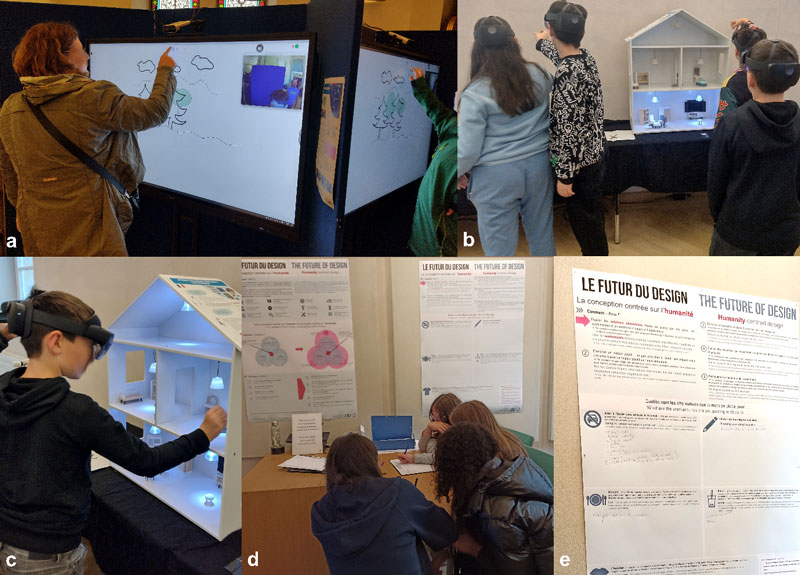by Lou Schwartz, Valérie Maquil, and Mohamed Saifeddine Hadj Sassi (Luxembourg Institute of Science and Technology)
The climate crisis demands the design of IT tools that address environmental concerns. But how to achieve this? We deployed three different approaches to find answers, identifying key challenges for future research in human-computer interaction.
In a situation of climate emergency with increasing pollution and waste, computer science researchers must question the impact of their research on sustainability and focus on how to design for the future. As highlighted by Norman [1], Humanity-Centred Design (HyCD) is a method for shaping sustainable futures, placing humanity at the forefront rather than focusing on individual needs. HyCD operates at the intersection of the environmental impact, the responsibility and ethics of the technology and the social impact and equity. This balance aims for fairness, supports those in need, and firmly opposes unethical practices like child labour. The five principles of HyCD are:
1. Solve the core root issues (i.e. the cause, not the symptoms).
2. Focus on the entire ecosystem of people (including all living things and the physical environment).
3. Take a long-term systems point of view.
4. Continually test and refine.
5. Design with the community and by the community.
However, it is not yet clear how a HyCD approach can be implemented in research for computer science and interactions.
A first good practice in HyCD is to look for workarounds already used by people and transform them into a sustainable product or a service with the objective of reducing users’ time, effort, research, and cost (e.g. How do people manage without packaging? How do people get to a place without a car?) [2].
An example of such a workaround is the use of video conferencing tools to avoid the need of travelling and the related impact on the environment. Experts that make essential decisions today, often rely on large interactive displays to present data in different scales and views and discuss them jointly in meetings. When meeting remotely and using video conferencing tools, they lose the overview of the data as well as the advantage to work in a collocated workspace where they can rely on non-verbal communication (i.e. gaze, gestures, body position, etc.) to make their intentions clear. Based on this workaround and their current practices, we developed an advanced video conferencing system that, in addition to a normal video connection, tracks and displays natural hand gestures (mid-air pointing, agree and disagree, and hand-raise gestures), touching and attention direction to allow a smoother and enhanced collaboration over distance on large interactive displays [L1], as shown in Figure 1(a). This system also enables indication of the authorship of each recognised action.

Figure 1: Humanity-centred-design approach implemented: a) advanced video conferencing system on large interactive displays; b) and c) eco-feedback technology using augmented reality; d) and e) activities to find workarounds with children.
But how to identify interesting workarounds? The main advice given by HyCD experts is to design with and/or by the communities of end users. In this way, we engaged children (8–15 years old) in activities to find workarounds for the need to receive education at school and to travel there by car, as seen in Figure 1(d) and Figure 1(e). Each workaround was then discussed to identify improvements that will facilitate easier adoption. The objective is twofold in this kind of activity. On the one hand, it enables collection of workarounds and maybe finding new ideas for a future more sustainable service or product. On the other hand, pupils were pushed to think about their own impact on the environment. The mentioned workarounds include home schooling and alternative transportation methods to get to school (e.g. on foot, by bike, by scooter, by e-scooter or by e-car). We observed that the notion of workaround is not obvious.
Enabling all citizens to think about their own impact, possible solutions and how they could apply them in their daily lives is a major lever of change. To enable citizens to think about their impact, an Eco-Feedback Technology (EFT) can be used. An EFT “provides feedback on individual or group behaviours with a goal of reducing environmental impact” [3]. We developed an EFT that gives feedback to participants about the impact of their daily decisions about food shopping at the supermarket (e.g. it is preferrable to avoid industrial food products and meat), or the equipment of a house (e.g. a shower is better than a bathtub, it is preferable to add solar panels), as seen in Figure 1(b) and Figure 1(c). We used augmented reality (AR) as it allows testing different behaviours and solutions without impacting the real world. This application was showcased at a public science fair, demonstrating practical applications of AR in environmental education.
Through our research we identified the following challenges for the design of sustainable human-computer interactions:
1. How can workarounds be identified and used as a basis for future research and solutions?
2. When a new technological solution is designed, what methods and measurement scales can be employed to evaluate its impact and ensure that it improved on or was at least in alignment with the principles of HyCD? [2]
3. How to enable citizens to better understand the situation and their impacts on each decision? [1]
Link:
[L1] https://www.list.lu/en/research/project/resurf/
References:
[1] D. A. Norman, Design for a better world: Meaningful, sustainable, humanity centered, MIT Press, 2023.
[2] L. Nancarrow and H. Koliji, The future of design thinking: from human-centered to humanity-centered, Whitepaper, Zensar Technologies, 2023.
[3] J. Froehlich, L. Findlater, and J. Landay, “The design of eco-feedback technology,” in Proceedings of the SIGCHI conference on human factors in computing systems, 2010, pp. 1999–2008).
Please contact:
Lou Schwartz, Luxembourg Institute of Science and Technology, Luxembourg











